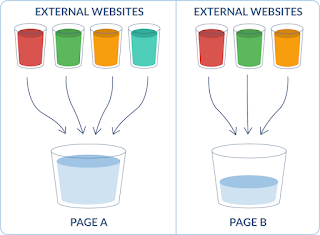SEO (Search Engine Optimization)
It is the process of growing quality and quantity of website traffic by increasing the visibility of website to user.
HISTORY OF SEO
In 90’s as a part of college
project Lary Page and Sergey Brin created a searching platform. So, after their
graduation in 1998 they founded a company and named it as Google. Then the Google search was possible by giving users mail id and the search result provided on
respective mail id. However, it took so much time lag of about 24 hours. Due to
the drawbacks of Google, people used Yahoo.com.
On Sep 11 2001, terrorists attacked
the World Trade Organisation (WTO) situated in US. At this time, most people
searched for the result of WTO on Google. But they can’t provide an accurate
result for that. It made the Google member’s embarrass. Therefore, they
conducted a meeting to solve this problem, in which they found google is not crawl-able.
ABOUT GOOGLE
There are 3 processes happening in
google-
1. Crawling - Crawling is the scanning of search result.-
2. Caching -
3. Indexing -
SEO EVOLUTION
For crawling, they form a program Googlebot to find new web page and scanning which saved in their database for further usage. They stored the data in SEO starter guide as pdf format.From this stored data, google can understand the user’s interest. They form an algorithm for metric level data changes – it is content specific (Niche).
There arise a problem of content specific google search optimization. People can make their website more relevant by focusing on their keywords.
Keyword stuffing is a black hat SEO technique and it is one of the main problem faced by content specific searches.
Two types of keyword stuffing are there:
· Ethical stuffing-
· Non-ethical stuffing- Is known as black hat hackers they use the data for immorality.
Therefore, to avoid the problem of keyword stuffing google changed niche specific platform into link specific format.
Also link specific format caused a big problem of referring from one page to another page, using their links in another sites etc.As a result, they changed link specific format into quality link specific format that will give page ranking out of 10. This quality link specific format has trust values. Gradually, people started promoting and adding links in their site for money. Therefore, websites got more reference for their links.
Due to this problem google introduced a new
strategy named Passing the Juice.
*Passing the juice in SEO world refers to the value or equity passed from one page or site to another. This value get passed through hyperlinks.
In cause of the equity-sharing
problem, sites reduced the sharing of another links. However, there arise a
problem of reference to another sites are not followed. So there introduced new
attribute Rel=”no follow” which doesn’t
pass equity of the websites to another.
Introduction to the advertisements
Meanwhile higher reach of google made them to start advertising on their platform.
Ads (AdWords):- Google’s advertising system in which advertisers
bid on certain keywords in order for their clickable ads to appear in google
search results.
AdSense:
- Designed for website publishers who want to display their ads and earn
money.
Pay Per Click (PPC)-For each and every click on ads made payment
for websites and google.
Changes of google from 2008 - 2010
Due to the introduction of ads even a small algorithm change will cause
big fluctuations in revenue of google.
In 2008- Android OS that introduced made a big growth for google, at this time strong algorithm changes doesn’t affect
the google revenue.
In 2009- User interaction ranking
began and google started suggesting the search words we searched earlier, that saved as
personal document.Also a new strategy called Bounce Rate was introduced to quantify the belief of user's in the website.
Bounce rate- Is calculated by the total number of one-page visits divided by the total number of entries to a website. When bounce rate increases ranking or belief in that site reduces, hence both are inversely proportional.
In 2010- Social media signalling
started. Ranking of websites promoted by social media according to the interactions and
sharing increased.




Comments
Post a Comment